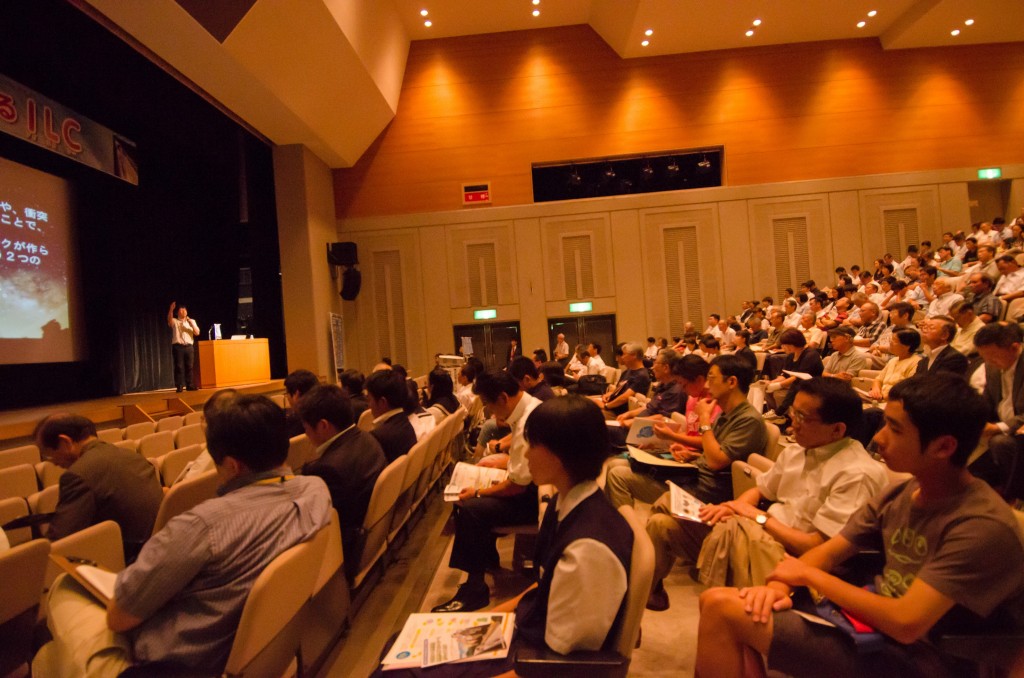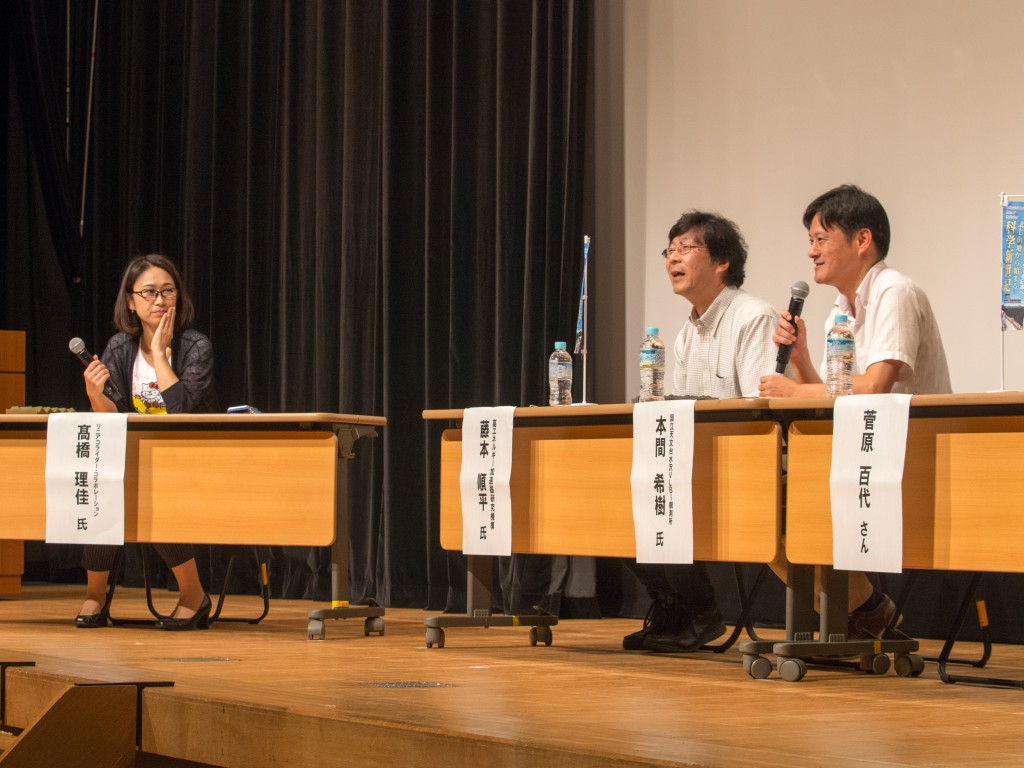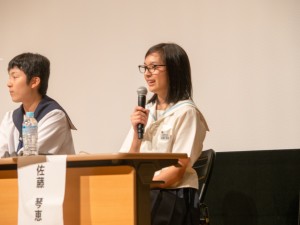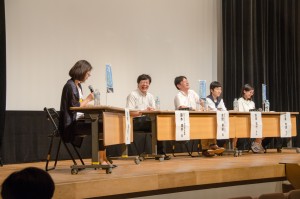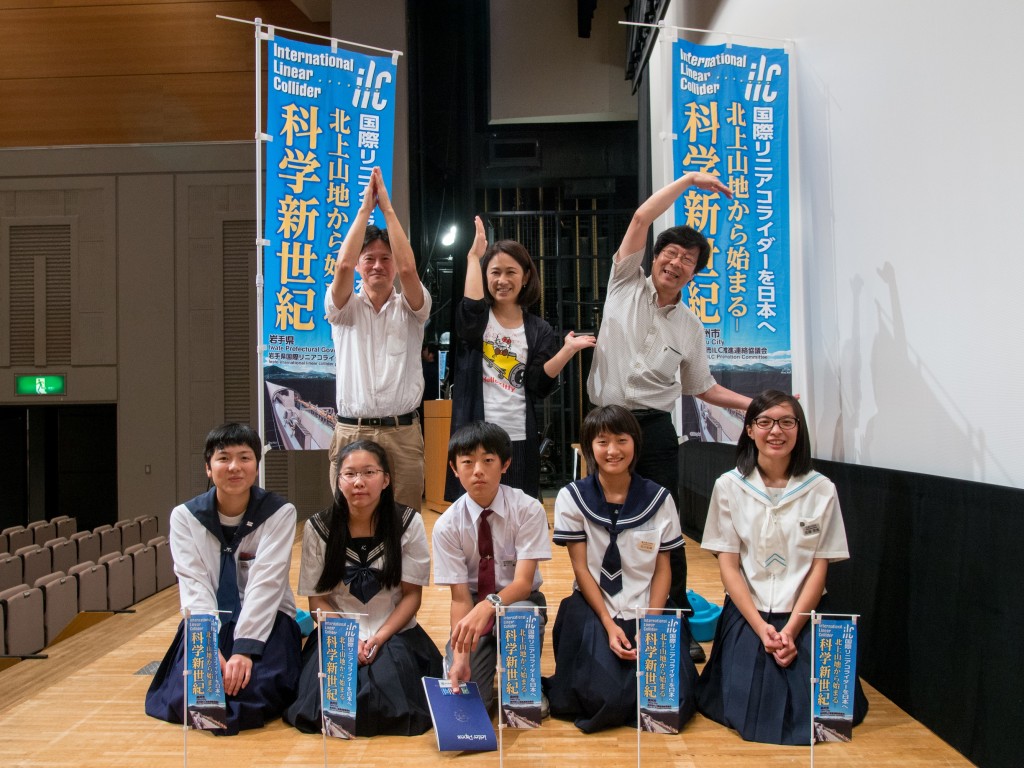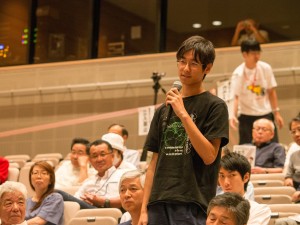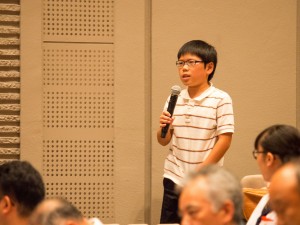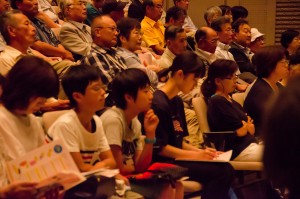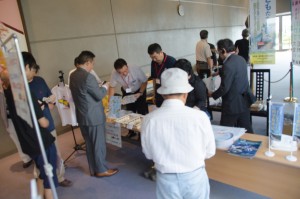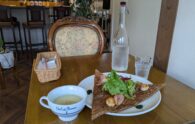Science story-tellers. Our future (aka, our youth). Science Hello Kitty. On September 10th, they all came together for the AAA Symposium in Tohoku 2016, held in Z-Hall, Oshu City! Called “Understanding the ILC in 1 Minute,” this symposium was focused on explaining the ILC in a way that’s easy to understand, as well as linking it to cool questions like “are there extra dimensions?” and “what is dark matter?”
KEK’s master science storyteller Dr. Junpei Fujimoto took the stage in part 1 to explain the ILC itself and the background behind the ILC. Science, he explained, is for understanding the laws of nature, without which we couldn’t build safe cars or airplanes, for example. Colliders like the ILC are necessary so we can see what nature/the universe is still hiding from us. The ILC could precisely measure the Higgs and Top Quark, and search for extra dimensions and dark matter.
Part 2 was a panel discussion between Dr. Fujimoto, LCC Communicator Ms. Rika Takahashi, director of the NAOJ Mizusawa VLBI Observatory Dr. Mareki Honma, later joined by local 3rd year junior high school students Momoyo Sugawara from Oshu Mizusawa Junior High School and Kotomi Sato of Ichinoseki Hanaizumi Junior High School.
The panel discussion, titled “The Universe We Observe; the Universe We Create – Searching for the Secret of Dark Matter,” was focused on how astronomy connects with particle physics through dark matter: astronomical observations show that dark matter is there, and have given “homework” to particle physicists to figure out what dark matter is.
After discussing how observatories found and measured dark matter, why dark matter is believed to be a particle, and how the ILC could find a particle that explains dark matter, the conversation turned to the joys and worries of working internationally. Fujimoto lamented that colleagues from France and Switzerland always start fights about whose chocolate is tastier. Honma, who had flown in from Thailand that morning, pointed out Oshu’s history of international research collaboration goes back to the Latitude Observatory that was built in 1899 in Mizusawa.
In the last part of the panel discussion, the stage got an infusion of youth from junior high school students Momoyo Sugawara and Kotomi Sato, two out of five members of the ILC Club, a group of junior high school students managed by Iwate Nippo Newspaper who visited CERN and meet regularly to discuss the ILC and how Iwate should prepare for it. Sugawara and Sato’s paths to joining the ILC Club were a little different: Sugawara became interested from a visit to KEK and JAXA through Oshu’s excursion program for middle school students, while Sato heard about the ILC and CERN in a school lecture.
From the approximately 300 participants to the youth participation from the audience and on the panel discussion (plus the brisk sales of Science Hello Kitty goods), “Understanding the ILC in 1 Minute” was a resounding success, as well as a tantalizing preview for the ILC Club’s future activities!
MEET THE ILC CLUB AT LCWS 2016!
What did the ILC Club think of CERN? What do these students think Iwate should do to prepare for the ILC? This is another reason to look forward to LCWS 2016 in December: the ILC Club will present their findings during the conference!
Japanese
「1から分かるILC」先端加速器科学技術推進シンポジウム2016 in東北
【奥州市】 アンナ・トマス
平成28年9月10日、科学の語り手、未来を担う若者、サイエンスハローキティが、奥州市Zホールで開催された「先端加速器科学技術推進シンポジウム2016in東北」に集まりました。「1から分かるILC」と題されたこのシンポジウムは、ILCを分かりやすく解説し、「余剰次元」や「ダークマター」などの謎に結びつけるものでした。
第一部では、高エネルギー加速器研究機構の藤本順平氏が、ILCの概要と、その研究の意義を説明しました。特に、科学とは宇宙の法則を正しく知るためのものであり、それが分からないと、例えば安全な車や飛行機は作ることができないと説明しました。また、ILCのような加速器は、自然・宇宙がまだ見せていない法則、例えばヒッグス粒子やトップクオークを詳しく調べることができ、余剰次元とダークマターを知るために必要なものだと述べました。
第二部では、藤本順平先生、リニアコライダー・コラボレーションコミュニケーターの高橋理佳さん、国立天文台水沢VLBI観測所の本間希樹所長とのパネルディスカッションが行われました。後半には、地元の中学3年生の菅原百代さん (奥州市立水沢中学校)と佐藤琴恵さん(一関市立花泉中学校)が加わりました。
「見る宇宙 つくる宇宙 ~ダークマターの秘密を探れ~」と題されたパネルディスカッションは、天文学がダークマターを通じてどのように素粒子物理学とつながるかということに焦点をあてたものでした。天文学者は、ダークマターの存在を示した一方で、素粒子物理学者に対し、その正体を見つけるよう「宿題」を出しました。そして、観測所がどのようにダークマターを発見・観測したのか、なぜダークマターが素粒子だと考えられているのか、ILCがどのようにダークマターの正体を探るのかという点について話し合ったあと、話題は国際的な環境で働くことの良い点と悪い点に移りました。フランスとスイス出身の研究者の同僚は、よく「どこのチョコレートが一番おいしいか」でけんかしてしまう、と藤本先生。今朝、タイから帰国した本間所長は、奥州市の国際共同研究の歴史は、1899年に建てられた水沢緯度観測所から続いていると指摘しました。
パネルディスカッションの後半では、中学生の菅原百代さんと佐藤琴恵さんが登場して、若々しい雰囲気となりました。菅原さんと佐藤さんは、岩手日報が企画した「ILCクラブ」メンバーの5人のうちの2人です。ILCクラブの5人の中学生は、セルンを視察し、その後も定期的にILCや岩手がどう準備すべきかについて話し合っています。菅原さんと佐藤さんがILCクラブに入るきっかけは少し異なり、菅原さんは奥州市教育委員会が主催したつくばのKEK、JAXAの研修で興味を持つようになりました。佐藤さんは出前授業の中で、ILCとセルンのことを知りました。
約300人の来場者や、パネルディスカッションでの積極的な若者の参加(加えて、サイエンスハローキティの活発な販売) など、「1から分かるILC」は大成功に終わり、またILCクラブの今後の活動の興味深い予告もありました。
ILCクラブのメンバーは、セルンについてどう思ったのか?岩手はILCに向けて何をすべきと考えたのか?12月のLCWS2016をお見逃しなく! ILCクラブが会議の開催期間に成果発表を行う予定です!

